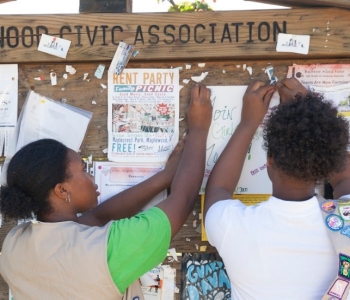Taking Action? These Are the Questions to Ask Your Troop

If your troop completed a community service project this year, your girls know just how good it feels to make a difference in their hometown. As they’re reveling in those feel-good vibes, it’s a great time to introduce the concept of making an even bigger impact through a Take Action project.
The main difference between a community service project and a Take Action project is the sustainability factor—how will the girls make sure their Take Action project has lasting impact, even after the project is complete?
Our volunteer experts shared how they approached the sustainability conversation with their girls, especially younger ones who may not grasp the concept of long-term impact.
Outline what sustainability means.
Encourage your girls to think about the future rather than the now. If your girls are younger, share a few examples so they’re clear about how they can make a long-term impact.
“As my girls were older, working on their Silver and Gold Awards and their Journey Take Action projects, we were able to tell them that, basically, their projects should not be just ‘one and done,’” says Lara Cordeiro of Girl Scouts of Western Ohio. “They needed to think about how it could go on and make a lasting difference, solving a problem rather than providing a short-term solution."
Brainstorm with the girls.
Your girls will have tons of ideas for how they can help their community, and that’s wonderful! Be sure to get them thinking through the ideas rather than telling them off the bat why they might not be as sustainable as they hope. Ask your troop questions like:
- We care about this issue a lot, but do we know what’s causing it? How does the project address the root of the problem?
- Who might be able to give us more information about the issue?
- Should this project be replicated? What would we need to do that?
- Who could help keep this project running from year to year?
- Who will note the steps we take to complete the project and how will we share our plan with everyone who needs it?
- What does success look like? Does it look the same every year?
"I ask questions that make them think a bit deeper than [than they might with] a spontaneous idea,” says Maranda Oliver of Girl Scouts of Wisconsin-Badgerland. “All of the [five W’s]: who will we involve, what will this entail from each girl, when can we schedule meeting times or when is the best time to put our plan into place, where will our choices lead us, how will this impact us as a troop (funds, emotionally/physically, commitment) and our community?”
“I did try to ask the girls a lot of questions to keep them focused on what they wanted to do and how it could be done,” says Lara. “I believe my girls can do anything they put their minds to, so if they wanted to do something that seemed difficult to me, I asked them to research how to do it. It was amazing what they came up with!"
“In the past, we have had some difficulty identifying a specific project because the girls often want to work in a general area but have found it difficult to select an actual course of action,” shares Linda Droege of Girl Scouts of the Green and White Mountains. “In those cases, we've suggested possible areas to consider and research the need and practicality, but the greatest success has come from projects where the girls had a clear vision about the change they wanted to effect.”
Get inspired by our volunteer experts!
“After a particularly difficult stretch in middle school, the Cadettes and Seniors decided to beautify the main girls’ restroom in their school to make it a refuge for girls who needed a welcoming safe space when they felt overwhelmed by peer pressure or bullying... [They asked], ‘Can we make the room feel like a hug?’” says Linda. “They went through the necessary steps of getting permission, fundraising for supplies, and researching affirming quotes they wanted to use to decorate the walls. They recruited any older girl who wanted to participate—Girl Scout or not—and held a lock-in one weekend to paint and redecorate. They wrote a fairly comprehensive plan to be used by any of the elementary schools to create the same [space] elsewhere and set up an advisory group of older girls to mentor their younger counterparts or help with actual hands-on painting and stenciling.”
“One girl wanted her project to be about sea turtles; her project [was to involve] cleaning up trash near the ocean,” says Maranda. “But we live nowhere near the ocean and hours away from even an aquarium with sea turtles. I told her not to let the geographical difficulty stop her from doing something involving sea turtles [and asked her to consider what issue regarding] sea turtles really bothers her. Was there something she's particularly worried about? She couldn’t pinpoint it exactly, but she knew that people litter and that this can be harmful to sea turtles. After some conversations, she is now leaning toward putting together a program that will inform [people and address] litter and recycling. This girl believes she can do the work locally, and even though it may be a small footprint in her hometown, it could have global effects in the future.”





